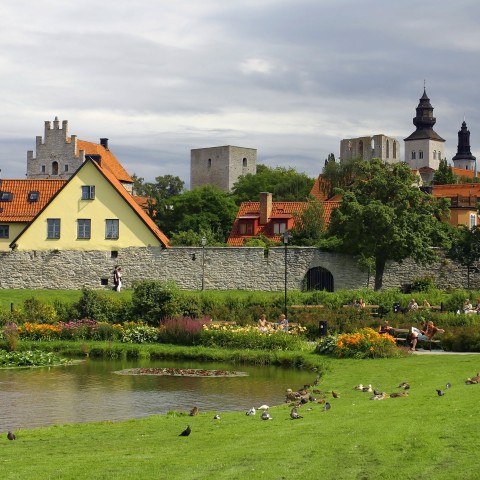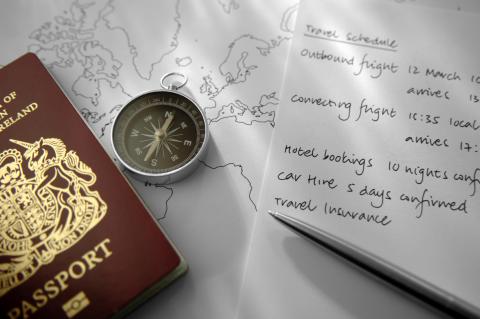
What are the first few words we learn in any language?
They’re the most basic nouns, verbs, adjectives, and adverbs that we need for daily interactions. But every language has advanced words that we don’t start learning until later on in our studies.
Once you master the basics, you can begin leveling up and perfecting your language skills by setting your sights on more advanced vocabulary. Luckily, you won’t have to search very far to unearth these word gems.
Below, we have compiled some of the most important advanced Swedish words for you to start studying.
 Table of Contents
Table of Contents
- Advanced Academic Words
- Advanced Business Words
- Advanced Medical Words
- Advanced Legal Words
- Advanced Swedish Verbs
- Advanced Swedish Adjectives
- Advanced Swedish Adverbs
- Conclusion
1. Advanced Academic Words

Learning academic vocabulary is crucial. For many people, it’s one of the most challenging aspects of learning a foreign language. When I was in school, I had to memorize the definition of every vocabulary word. But the acquisition of foreign languages doesn’t quite work that way.
There are two main reasons for this. First, knowing the definition of a word doesn’t mean you know how to use it in a sentence. Second, the meaning of a word can vary slightly depending on the context.
In scientific studies, articles, and other academic texts, words are defined more concretely than in regular conversation. Additionally, words that have more than one meaning are often used differently in academic contexts than they are elsewhere.
But let’s keep things simple here. Below are a few advanced Swedish words related to academia.
| Swedish | English | Swedish Example Sentence | English Example Sentence |
| Dock (adv.) | However | Det stämmer dock inte. | However, that is not true. |
| Relation (n.) | Relation / Relationship | 1: Det finns ingen relation mellan händelserna. 2: De har inlett en relation tillsammans. | 1: There’s no relation between the events. 2: They have started a relationship together. |
| Studie (n.) | Study | Resultatet presenteras i en ny studie. | The result is presented in a new study. |
| Social (adj.) | Social | Hon är social och gillar andra människor. | She is social and likes other people. |
| Begrepp (n.) | Concept | Det är ett välkänt begrepp. | It’s a well-known concept. |
| Form (n.) | Form / Shape | Det är en form av kampsport. Han är i god form innan tävlingen. | It’s a form of martial arts. He’s in good shape before the competition. |
| Betydelse (n.) | Significance | Det är en bagatell och utan större betydelse. | It’s a trifle and without much significance. |
| Analys (n.) | Analysis | Det framgår i analysen. | That is made clear in the analysis. |
| Utifrån (adv.) | Based on | Det gick bra utifrån omständigheterna. | It went well based on the circumstances. |
| Perspektiv (n.) | Perspective | Våra perspektiv skiljer sig åt. | Our perspectives differ. |
| Beskriva (v.) | Describe | Jag kan inte beskriva hur lycklig jag är. | I cannot describe how happy I am. |
| Text (n.) | Text | Ni behöver skriva en kort text om ämnet. | You need to write a short text on the topic. |
| Innebära (v.) | Mean | Det kommer innebära slutet för oss! | It will mean the end for us! |
| Exempelvis (adv.) | For example | Du kan exempelvis gå till sängs, eller läsa en bok. | For example, you can go to bed or read a book. |
| Utgöra (v.) | Constitute | De kommer inte att utgöra ett hot länge till. | They will not constitute a threat for long. |
| Orsak (n.) | Reason | Det finns ingen orsak till oro. | There is no reason for concern. |
| Såväl (con.) | As well | Han har arbetat inrikes såväl som utrikes. | He has worked domestically as well as abroad. |
| Enligt (prp.) | According to | Det går inte enligt dem. | That’s not possible, according to them. |
| Därmed (adv.) | Thus | Därmed slutar vår saga så som den började. | Thus ends our fairy tale as it began. |
| Diskussion (n.) | Debate | Vi får ta upp det till diskussion på mötet. | We will have to bring it up for discussion at the meeting. |
| Samband (n.) | Connection | Det finns inget samband mellan de två fallen. | There is no connection between the two cases. |
| Forskning (n.) | Research | Vi behöver mer forskning på ämnet. | We need more research on the subject. |
| Dels (con.) | Partly | Det är dels mitt fel, och dels hennes. | It’s partly my fault, and partly hers. |
| Tolkning (n.) | Interpretation | Slutet är öppet för tolkning. | The ending is open to interpretation. |
| Referera (v.) | To refer | Jag får lov att referera till expertis på området. | I will have to refer to expertise in the field. |
(Part of speech: n; noun, v; verb, adj; adjective, adv; adverb, prp; preposition, con; conjunction)
2. Advanced Business Words

In addition to academic words, business vocabulary is incredibly important. You’ll need to know this type of vocabulary before applying for a job or doing anything that requires a formal report/presentation.
In the professional world, we use many more advanced words than we do in everyday conversations. This is true even if our job doesn’t require any special training.
For example, let’s say you encounter a difficult situation at work and want to talk about it with your boss. You might say something like, “That was an unfortunate circumstance.” If you were talking to anyone other than a superior, such as your friends or family, you would probably use the word “unlucky” instead.
As you approach an advanced level in Swedish, becoming familiar with this special set of terminology will certainly give you a leg up in the business world.
| Swedish | English | Swedish Example Sentence | English Example Sentence |
| Division (n.) | Division | Vi studerar multiplikation och division. | We study multiplication and division. |
| Huvudkontor (n.) | Head office | Var ligger deras huvudkontor? | Where is their head office? |
| Outsourcing (n.) | Outsourcing | Han fick sparken på grund av outsourcing. | He was fired due to outsourcing. |
| Uppsägning (n.) | Termination | Det räcker med en varning istället för uppsägning. | A warning instead of termination is enough. |
| Tillgångar (n.) | Assets | Tillgångarna överstiger utgifterna. | The assets exceed the expenses. |
| Lager (n.) | Stock | Oroa dig inte, vi har flera på lager. | Don’t worry; we have several in stock. |
| Aktieägare (n.) | Shareholder | Styrelsens beslut lär inte vara populärt hos aktieägarna. | The board’s decision is not likely to be popular with the shareholders. |
| Ränta (n.) | Interest rate | Vad erbjuder banken för ränta? | What interest rate does the bank offer? |
| Personalavdelning (n.) | Human resources department | Hon arbetar vid personalavdelningen. | She works in the human resources department. |
| Omsättning (n.) | Turnover | Omsättningen ökade under det andra kvartalet. | Turnover increased during the second quarter. |
| Medel (n.) | Funds | Det saknas medel till att investera. | There are no funds to invest. |
| Dotterbolag (n.) | Subsidiary | De öppnade ett dotterbolag dit de kunde flytta kostnaderna. | They opened a subsidiary where they could move the costs. |
| Avgift (n.) | Fee | Det tillkommer en avgift för sittplats. | There is an additional fee for seating. |
| Lönebesked (n.) | Payslip | Skatten framgår på lönebeskedet. | The tax appears on the payslip. |
| Partnerskap (n.) | Partnership | Deras partnerskap var bräckligt. | Their partnership was fragile. |
| Arbetsmarknad (n.) | Labor market | Arbetsmarknaden har återhämtat sig efter lågkonjunkturen. | The labor market has recovered from the recession. |
| Kompensera (v.) | Compensate | Vi kommer att kompensera dig för uppdraget. | We will compensate you for the assignment. |
| Ansöka (v.) | Apply | Jag kommer att ansöka till tjänsten. | I will apply for the position. |
| Gren (n.) | Branch | Avbrottet kommer att påverka samtliga grenar av företaget. | The interruption will affect all branches of the company. |
| Bokföring (n.) | Accounting | De kom undan med det på grund av kreativ bokföring. | They got away with it because of creative accounting. |
| Registrerat varumärke (n.) | Registered trademark | Produkten lyder under ett registrerat varumärke och får inte kopieras utan tillstånd. | The product is subject to a registered trademark and may not be copied without permission. |
| Konkurs (n.) | Bankruptcy | Om inte vinsten ökas är en konkurs nära förestående. | Unless the profit is increased, bankruptcy is imminent. |
| Affärsresa (n.) | Business trip | Han är på affärsresa, kan jag ta ett meddelande? | He’s on a business trip; can I take a message? |
| Tillsvidareanställning (n.) | Permanent contract | Efter sex månader övergår det till en tillsvidareanställning. | After six months, it will be changed to a permanent contract. |
| Visstidsanställning (n.) | Fixed-term contract | De hittar alltid något skäl till att sparka en vid avslutat visstidsanställning. | They always find some reason to fire you at the end of a fixed-term contract. |
| Chef (n.) | Boss | De kom relativt väl överens med chefen. | They got along relatively well with the boss. |
(Part of speech: n; noun, v; verb, adj; adjective, adv; adverb, prp; preposition, con; conjunction)
3. Advanced Medical Words

I’m not a doctor, but as someone who has had to visit the doctor on several occasions, I know how important it is to understand what’s being said. For me, the worst part about going to the doctor is feeling clueless and helpless. I feel a lot better when I can ask questions and get answers in my native language.
Luckily, in most countries, there are professional medical interpreters available to help you communicate with your doctor. If that’s not an option for you, use the following list of advanced Swedish words to start learning the most important medical vocabulary.
| Swedish | English | Swedish Example Sentence | English Example Sentence |
| Behandling (n.) | Treatment | Som tur var svarade hon väl på behandling. | Fortunately, she responded well to treatment. |
| Godartad (adj.) | Benign | Det är en godartad tumör. | It is a benign tumor. |
| Sterilisera (v.) | Sterilize | Ni behöver sterilisera verktygen innan operationen. | You need to sterilize the tools before the operation. |
| Smittsam (adj.) | Contagious | Sjukdomen är inte smittsam. | The disease is not contagious. |
| Bedöva (v.) | Anesthetize | Vi kommer att bedöva området innan det första snittet sker. | We will anesthetize the area before the first incision is made. |
| Allergi (n.) | Allergy | Har du några allergier vi behöver känna till? | Do you have any allergies we need to know about? |
| Blodtryck (n.) | Blood pressure | Han led av högt blodtryck på grund av övervikt. | He was suffering from high blood pressure due to being overweight. |
| Fraktur (n.) | Fracture | Röntgen visar på en fraktur i lårbenet. | The X-ray shows a fracture in the femur. |
| Röntgen (n.) | X-ray | Vi behöver ta röntgen för att se ifall en fraktur föreligger. | We need to take an X-ray to see if there is a fracture. |
| Antibiotika (n.) | Antibiotics | Endast bakteriella infektioner kan behandlas med antibiotika. | Only bacterial infections can be treated with antibiotics. |
| Hjärtattack (n.) | Heart attack | Han avled i en hjärtattack. | He died of a heart attack. |
| Immunförsvar (n.) | Immune system | Immunförsvaret måste utmanas för att bli starkare. | The immune system must be challenged to become stronger. |
| Blödning (n.) | Bleeding | Vi måste få stopp på blödningen innan vi syr igen såret. | We have to stop the bleeding before we stitch up the wound. |
| Vaccinera (v.) | Vaccinate | Det är en sjukdom som går att vaccinera mot. | It is a disease that can be vaccinated against. |
| Recept (n.) | Prescription | Du behöver ett recept för att få det läkemedlet. | You need a prescription to get that medicine. |
| Biverkan (n.) | Side effect | Högt blodtryck och yrsel är kända sidoeffekter hos medicineringen. | High blood pressure and dizziness are known side effects of the medication. |
| Blodprov (n.) | Blood test | Blodprovet visade positivt för olagliga substanser. | The blood test showed positive for illegal substances. |
| Influensa (n.) | Influenza | Årets influensa ger en ovanligt hög feber. | This year’s influenza gives an unusually high fever. |
| Klåda (n.) | Itching | Betten kan leda till klåda och rodnad. | The bite can lead to itching and redness. |
| Menstruation (n.) | Menstruation | Graviditetstest tas vid försenad menstruation. | Pregnancy tests are taken in case of delayed menstruation. |
| Svalg (n.) | Pharynx | Patienten har halsont med synbar rodnad i svalget. | The patient has a sore throat with visible redness in the pharynx. |
| Mage (n.) | Stomach | För mycket kryddor gjorde att hon fick ont i magen. | Too much spice made her stomach ache. |
| Ryggrad (n.) | Spine | Efter olyckan var de noga med att ryggraden hölls stilla. | After the accident, they made sure that the spine was kept still. |
| Revben (n.) | Ribs | Han knäckte ett revben i matchen. | He broke a rib in the match. |
| Lungor (n.) | Lungs | Lungorna är skadade av rökning. | The lungs are damaged by smoking. |
| Infektion (n.) | Infection | Vi behandlar infektionen med antibiotika. | We treat the infection with antibiotics. |
(Part of speech: n; noun, v; verb, adj; adjective, adv; adverb, prp; preposition, con; conjunction)
4. Advanced Legal Words

The next set of advanced Swedish vocabulary we’ll look at consists of words related to the law. Keep in mind that legal terms can vary slightly depending on the country or region you live in, as well as the legal system you’re referring to.
For example, in the United States, words like “district attorney” and “prosecutor” have different meanings than they do in the United Kingdom. But no matter where you live, it’s important to understand basic terms like “murder” and “assault.”
For both legal professionals and the general public, knowing these words is essential. This is especially true if you frequently engage with legal professionals in your personal or professional life. For example, if you need to hire a lawyer or go through the court system, being familiar with basic legal terms will help you communicate with your attorney.
Legal words are particularly difficult for many people to learn because they’re generally abstract and complex. They also tend to have multiple meanings.
The list below will help you get started with legal vocabulary in Swedish.
| Swedish | English | Swedish Example Sentence | English Example Sentence |
| Auktoriserad (adj.) | Authorized | Vi hänvisar dig till en auktoriserad återförsäljare. | We refer you to an authorized dealer. |
| Förlikning (n.) | Settlement | De två parterna nådde en förlikning. | The two parties reached a settlement. |
| Brottsregister (n.) | Criminal record | Brottsregister kommer att kontrolleras under anställningsprocessen. | Criminal records will be checked during the recruitment process. |
| Appellationsdomstol (n.) | Court of appeals | Ytterligare klagomål får du ta upp med appellationsdomstolen. | You can take up further complaints with the court of appeals. |
| Juridiskt biträde (n.) | Legal counsel | Offret saknade juridiskt biträde. | The victim lacked legal counsel. |
| Rättslig (adj.) | Legal | Det är osannolikt att det leder till rättslig påföljd. | It is unlikely that it will lead to legal repercussions. |
| Bevis (n.) | Evidence | Vad har ni för bevis för påståendet? | What evidence do you have for the claim? |
| Kalla (v.) | Summon | Målsäganden kallar sitt första vittne. | Plaintiffs summon their first witness. |
| Juridiska ombud (n.) | Legal representative | Som anklagad har du rätt till juridiskt ombud. | As an accused, you have the right to a legal representative. |
| Registrera (v.) | Register | Det är registrerat till protokollet. | It is registered to the protocol. |
| Tvist (n.) | Dispute | Halva styrelsen är inblandade i rättsliga tvister. | Half the board is involved in legal disputes. |
| Husrannsakan (n.) | Warrant | Utan husrannsakan kommer ni inte in! | Without a warrant, you will not enter! |
| Företrädare (n.) | Representative | Jag är företrädare i fallet då den drabbade på grund av sina skador inte kan närvara. | I am a representative in the case as the victim is unable to attend due to his injuries. |
| Notarie (n.) | Notary | Vi ber notarien stryka det från protokollet. | We ask the notary to delete it from the minutes. |
| Skjuta upp (v.) | Postpone | Vi har inget annat val än att skjuta upp det till ett senare tillfälle. | We have no choice but to postpone it to a later date. |
| Rättegång (n.) | Trial | Ni kommer att kallas till rättegång då åklagaren har tillräcklig bevisning. | You will be called to trial when the prosecutor has sufficient evidence. |
| Allmän åklagare (n.) | Public prosecutor | Som allmän åklagare har hon ont om tid. | As a public prosecutor, she is short of time. |
| Hävda (v.) | Claim | Du hävdar alltså att någon planterade bevismaterialet på dig? | So, you claim that someone planted the evidence on you? |
| Betalning (n.) | Payment | Skulle betalningen vara sen tillkommer en straffavgift. | Should the payment be late, a penalty fee will be added. |
| Kidnappning (n.) | Kidnapping | Polisen utreder just nu brottet som en kidnappning. | Police are currently investigating the crime as a kidnapping. |
| Angripare (n.) | Assailant | Angriparen var tydligt berusad. | The assailant was clearly intoxicated. |
| Bestickning (n.) | Bribery | Han meddelades avsked på grund av bestickning. | He was fired due to bribery. |
| Inbrott (n.) | Burglary | Gemene man vill att inbrott bestraffas betydligt hårdare. | The common man wants burglary to be punished much more severely. |
| Utpressning (n.) | Blackmail | Bilderna användes för utpressning. | The pictures were used for blackmail. |
| Hot (n.) | Threat | De fick ett antal hot via sociala medier. | They received a number of threats via social media. |
| Misshandel (n.) | Assault | Han var anklagad för misshandel, men hävdade självförsvar. | He was accused of assault, but claimed self-defense. |
(Part of speech: n; noun, v; verb, adj; adjective, adv; adverb, prp; preposition, con; conjunction)
5. Advanced Swedish Verbs
At this stage in your Swedish learning journey, you probably know quite a lot of nouns and pronouns. Now, let’s move on to something equally important: Swedish verbs.
In the English language, verbs can be either regular or irregular. Regular verbs are those that follow predictable conjugation patterns to form the past, present, and future tenses. For example, they’re conjugated for the past tense by adding “-ed” or “-d” to the end of the verb: “walked.”
By contrast, verbs that are considered irregular need an entirely different structure to form the past, present, and future tenses. For example, the past tense of “sing” is “sang,” not “singed.”
Even though there are irregular verbs in Swedish, many speakers of Romance languages (like French and Italian) find it really easy to learn most Swedish verbs because their conjugation is so simple.
Additionally, many common verbs in the Swedish language are very similar to English verbs, but with a unique pronunciation.
For example, in English, we say “I have a home” and “I had a home.” In Swedish, that comes out as Jag har ett hem and Jag hade ett hem. In this case, the perfect tense of “had” and hade surely tells the tale that these are closely related languages.
Let’s take a closer look at some of the most important verbs you’ll want to learn in the Swedish language.
| Swedish | English | Swedish Example Sentence | English Example Sentence |
| Att börja | To start | Jag börjar varje morgon med frukost. | I start each morning with breakfast. |
| Att länka | To link | Genom att länka till sidan ökar dess popularitet. | By linking to the page, its popularity increases. |
| Att skriva | To write | Jag älskar att skriva brev. | I love writing letters. |
| Att utse | To nominate | Vi kommer att utse dig till borgmästare. | We will appoint you mayor. |
| Att visa | To show | Glöm inte att visa din legitimation. | Do not forget to show your ID. |
| Att berömma | To praise | Det är viktigt att berömma dem då de gör något bra. | It is important to praise them when they do something good. |
| Att ha | To have | Det är bra att ha mat i skafferiet. | It is good to have food in the pantry. |
| Att säga | To say | Jag har en hel del att säga till skolstyrelsen. | I have a lot to say to the school board. |
| Att delta | To participate | De riktigt små barnen får pris bara för att delta. | The really small children get a prize just for participating. |
| Att initiera | To initiate | När du är redo kan du initiera startproceduren. | When you are ready, you can initiate the startup procedure. |
| Att balansera | To balance | Han balanserade på en lina mellan två skyskrapor. | He balanced on a rope between two skyscrapers. |
| Att omfamna | To embrace | Låt mig omfamna er i all vänskaplighet! | Let me embrace you in friendship! |
| Att förbättra | To enhance | Minneskorten kommer att förbättra datorprestandan avsevärt. | The memory cards will significantly improve computer performance. |
| Att utveckla | To elaborate | Kan du utveckla argumentet lite närmare? | Can you elaborate on the argument a little further? |
| Att samarbeta | To collaborate | Jag tror vi kan lyckas om vi samarbetar. | I believe we can succeed if we cooperate. |
| Att framkalla | To evoke | Filmen framkallade sentimentala minnen hos mig. | The film evoked sentimental memories in me. |
| Att särskilja | To distinguish | Det är svårt att särskilja årets modell från de tidigare. | It is difficult to distinguish this year’s model from the previous ones. |
| Att artikulera | To articulate | Försök att artikulera bättre för ökad förståelse. | Try to articulate better for greater understanding. |
6. Advanced Swedish Adjectives
As you might have guessed, advanced Swedish adjectives are very similar to those in the English language. However, there are some slight spelling and pronunciation changes when converting an English adjective into Swedish.
For example, the English adjective “good” is irregular and declines as “better” and “best.” The Swedish word for “good” is bra, and the similarities can be seen in the likewise irregular comparative and superlative forms bättre and bäst.
Swedish adjectives also decline based on gender to some extent. Let’s see an example using the superlative “best”:
- Vi behöver den bäste mannen för jobbet. (“We need the best man for the job.”)
- Vi behöver den bästa kvinnan för jobbet. (“We need the best woman for the job.”)
It may take time to get used to these changes, but once you do, speaking Swedish will become much easier. In fact, you’ll start to pick up on them even before you’ve completely mastered the words.
Here are some advanced Swedish adjectives you may not have learned yet.
| Swedish | English | Swedish Example Sentence | English Example Sentence |
| Grundläggande | Fundamental | Rätten till liv är en grundläggande rättighet. | The right to life is a fundamental right. |
| Bekväm | Comfortable | Hemleverans är en bekväm lösning. | Home delivery is a comfortable solution. |
| Annorlunda | Different | Hon bar en något annorlunda jacka, med lila tofsar. | She wore a somewhat different jacket, with purple tassels. |
| Lätt | Easy | Det är inte alltid lätt att stiga upp på morgonen. | Getting up in the morning is not always easy. |
| Svår | Difficult | Det är en svår fråga, kan du ge mig en ledtråd? | That’s a difficult question; can you give me a clue? |
| Knepig | Tricky | Vi har hamnat i en knepig situation utan uppenbar lösning. | We have ended up in a tricky situation without an obvious solution. |
| Obekväm | Inconvenient | Jag blev obekväm i deras sällskap och valde att gå hem. | I became uncomfortable in their company and chose to go home. |
| Jobbig | Annoying | Han kunde bli jobbig ibland då han kände sig utanför. | He could become annoying sometimes when he felt left out. |
| Kritisk | Critical | Detta är en kritisk situation och vi måste agera snabbt! | This is a critical situation, and we must act quickly! |
| Självständig | Independent | Det är en självständig nation och vi saknar auktoritet där. | It is an independent nation and we lack authority there. |
| Komplicerad | Complicated | Det är en komplicerad maskin som jag inte förstår mig på. | It’s a complicated machine that I do not understand. |
| Teknisk | Technical | Vårt tekniska kunnande leder oss till framgång. | Our technical know-how leads us to success. |
| Lycklig | Happy | Sagan fick ett lyckligt slut. | The story had a happy ending. |
| Underhållande | Entertaining | Det var en underhållande film. | It was an entertaining movie. |
| Uppfriskande | Refreshing | Vill du ha något uppfriskande att dricka? | Do you want something refreshing to drink? |
| Gammaldags | Old-fashioned | Det är en gammaldags lösning, men alltjämt effektiv. | It is an old-fashioned solution, but still effective. |
| Segrande | Victorious | Vi gick segrande ur kampen. | We emerged victorious from the battle. |
| Charmig | Charming | Han var oerhört charmig och alla tyckte om honom. | He was extremely charming, and everyone liked him. |
7. Advanced Swedish Adverbs
Just like with English, many adjectives in Swedish can be transformed into adverbs by simply adding a suffix.
For example, the English adjective “quick” can easily be changed into the adverb “quickly” by adding the suffix “-ly.” The Swedish adjective with the same meaning is snabb, which can be changed into the adverb snabbt. The Swedish suffix most commonly used for this purpose is, as you might have guessed, “-t.”
There are, of course, many adverbs that are not directly linked to an adjective, but they are quite often similar to their English counterparts as well. For example:
- Soon (Snart)
- Afterward (Efteråt)
- Often (Ofta)
It might take some time for you to get used to writing Swedish adverbs. However, the good news is that it’s not so difficult to learn the most common ones.
| Swedish | English | Swedish Example Sentence | English Example Sentence |
| Enkelt | Easily | Han lyfte enkelt vikten över huvudet. | He easily lifted the weight over his head. |
| Nu | Now | Jag går hem nu. | I’m going home now. |
| Före | Before | Ät inte godis före middagen. | Do not eat sweets before dinner. |
| Mer | More | Jag vill ha mer kaka! | I want more cake! |
| Onormalt | Abnormally | Du sover onormalt mycket nu för tiden. | You sleep abnormally much these days. |
| Hopplöst | Hopelessly | Hon är hopplöst förälskad i honom. | She is hopelessly in love with him. |
| Tvivelaktigt | Doubtfully | Han såg tvivelaktigt på mig. | He looked at me doubtfully. |
| Ljudligt | Noisily | Vagnen rullade ljudligt in på gården. | The cart rolled noisily into the yard. |
| Intensivt | Intensely | Man kunde höra någon intensivt skratta från grannrummet. | You could hear someone intensely laughing from the next room. |
| Intressant | Interestingly | Intressant nog pågår seden fortfarande. | Interestingly enough, the custom is still going on. |
| Oväntat | Unexpectedly | Han sparkade oväntat upp dörren. | He unexpectedly kicked the door open. |
| Motvilligt | Reluctantly | Hon skrattade motvilligt åt det grova skämtet. | She laughed reluctantly at the crude joke. |
| Oerhört | Tremendously | Det är en oerhört imponerande trädgård du har! | It is a tremendously impressive garden you have! |
| Optimistiskt | Optimistically | Nu är det viktigt att vi ser optimistiskt på saken. | At this point, it is important that we look at the matter optimistically. |
| Knappt | Barely | Han hade knappt fyll sju år. | He had barely celebrated his seventh birthday. |
| Lydigt | Obediently | De slog lydigt undan med blicken. | They obediently looked away. |
| Alltid | Always | Det finns alltid plats för en till. | There is always room for one more. |
| Rasande | Furiously | Han sprang rasande efter dem. | He ran furiously after them. |
8. Conclusion
It’s easy to get comfortable with the words you know in Swedish, but a challenge awaits for those who want to learn more.
Learning advanced Swedish vocabulary is necessary if you need to discuss legal issues with a lawyer, explain health concerns to a doctor, or attend university in this beautiful country. Luckily, there are many resources available to help people learn the basics and level up to native-like fluency.
SwedishPod101 is the most comprehensive resource you could lay your hands on. Here, you can find thousands of lessons in audio, video, and text format—all designed to help you learn Swedish in the fastest, easiest, and most fun way possible.
Happy learning!
Lycka till!

30 Practical Swedish Phone Call Expressions

With the advance of technology, more and more of us hide behind texting, Facebook, Instagram, and more.
We all want to respond to people on our own schedule, and at our convenience.
But guess what?
There will always come a moment when you get a phone call you have to take or need to make one yourself. You can’t refuse the call from the delivery guy, and you definitely won’t want to refuse the phone interview for your dream job.
It always comes down to making those phone calls.
As such, language learners will benefit from memorizing some Swedish phone call expressions, even in our SMS-based world.
But phone anxiety is bad enough in one’s native language, let alone in a foreign language like Swedish!
Just picture the delivery guy calling so you can help them find your home, and the only language they speak is Swedish.
Know how to start the conversation? Ask them to switch to text? Or even agree with them on a meeting point?
To give you a headstart, SwedishPod101 has compiled this handy list of 30 Swedish telephone call phrases. We’ve also provided two bonus sample conversations at the end of this article!
 Table of Contents
Table of Contents
- Picking up the Phone
- Saying Who You Are
- Stating the Reason for Your Call
- Asking to Speak to Someone
- Asking Someone to Wait
- Leaving a Message
- Asking for Clarification
- Ending the Phone Call
- Sample Phone Conversations
- Conclusion
1. Picking up the Phone

Swedes have a unique way of picking up the phone. They start the call by mentioning whose home you’re “at” (if you happen to be calling someone’s home). The basic expression is:
At [homeowner’s name].
Hos [homeowner’s name].
An extended version of this expression is to start with your first name:
[First name] at [homeowner’s name].
[First name] hos [homeowner’s name].
Besides these unique Swedish expressions, you can use others that are similar to those commonly used in English.
This magic word is as informal as it gets:
Howdy.
Hejsan.
And if you want something a little less informal, you can use:
Hello.
Hallå.
And for formal calls, use one of these two phrases:
Good day.
God dag.
[First name. / Family name.]
2. Saying Who You Are

This may not be relevant when talking with acquaintances or friends, but it’s a crucial part of formal phone calls or conversations with strangers.
This is [name].
Det här är [namn].
This is [name], from [company].
Det här är [namn], från [företag].
3. Stating the Reason for Your Call
Rehearsing this part to mastery is a must. You’ll want to clearly express the purpose of your call and leave no room for mumbling. Otherwise, your call will be pretty much pointless. Here are a few expressions you can use:
I’m calling to ask… / confirm… / make a reservation…
Jag ringer för att fråga … / bekräfta … / göra en reservation…
I’d like to speak to someone about…
Jag skulle vilja prata med någon om…
I’m returning your call.
Jag svarar på ditt samtal.
4. Asking to Speak to Someone

Sometimes, the person who picks up the phone is not the person you intended to call. In that case, there are a few ways you can ask to be handed over to the correct person:
May I speak to…?
Kan jag få tala med…?
Is [name] there?
Finns [namn] där?
Is Mr. Andersson in office today?
Är herr Andersson i tjänst idag?
Is Mr. Gustavsson available now?
Är Mr. Gustavsson tillgänglig nu?
5. Asking Someone to Wait

Especially in formal contexts, it’s common to have to put someone on hold for a couple of minutes. Here are three ways you can politely ask someone to wait:
Just a moment, let me check.
Ett ögonblick, låt mig kolla.
I’ll put you on hold for a second.
Jag låter dig vänta en stund.
Let me transfer you to his office. Stay on the line, please.
Låt mig koppla dig till hans kontor. Stanna kvar på linjen tack.
6. Leaving a Message
If the person you wish to speak to is not available, you may be able to leave a voicemail or have a message relayed to them. Here are some phrases you can use to leave a message in Swedish over the phone:
Please let him know…
Var god låt honom veta…
Can I leave a message?
Kan jag lämna ett meddelande?
Can you tell him to call me back at [phone number]?
Kan du be honom ringa mig på [telefonnummer]?
7. Asking for Clarification

As a non-native speaker making a phone call in Swedish, you may need to ask for clarification at some point. This is nothing to be embarrassed about! Below are a few expressions you can use to make sure you understand what the other person is saying.
Sorry, could you say that again?
Ursäkta, kan du säga det igen?
I’m sorry, but I’m having a hard time hearing you. I think there’s a bad connection.
Jag beklagar, men jag har svårt att höra dig. Jag tror att anslutningen är dålig.
Could you spell your name for me, please?
Kan du bokstavera ditt namn åt mig är du snäll?
Just to double check…
Bara för att dubbelkolla…
8. Ending the Phone Call
Whether your call was a success or not, you should aim to leave a good final impression. Here are some ways you can end a conversation over the phone in Swedish:
Anything else I can help with?
Något annat jag kan hjälpa till med?
You’ve been very helpful. Thank you.
Du har varit till stor hjälp. Tack.
See you at ___ on ___.
Vi ses kl ___ på ___.
Have a great day.
Ha en bra dag.
It’s been a pleasure talking to you.
Det har varit ett nöje att prata med dig.
9. Sample Phone Conversations
Finally, let’s make sure you know how to use the phrases we covered! Here are two sample Swedish phone conversations, one informal and one formal.
Informal phone conversation
Two friends are setting up a time to meet for a Swedish fika on a weekend. Here’s a short conversation they’ve had on the phone:
Lars: Hallå.
Mikael: Hallå.
Lars: Hello.
Mikael: Hello.
Lars: Hur mår du?
Mikael: Bra. Jag studerar för en examen. Och du då?
Lars: How are you doing?
Mikael: Good. I’m studying for an exam. How about you?
Lars: Jag mår bra tack. Jag läser en bok.
Mikael: Trevligt.
Lars: I’m good, thanks. I’m reading a book.
Mikael: Nice.
Lars: Är du i stan under helgen?
Mikael: Ja, har du några planer?
Lars: You’re in town on the weekend?
Mikael: Yes, you have any plans?
Lars: Vill du gå på fika i helgen?
Mikael: Ja, varför inte! När?
Lars: Want to go for fika this weekend?
Mikael: Yeah, why not! When?
Lars: På eftermiddagen.
Mikael: Kan du gå ut klockan 2 på eftermiddagen?
Lars: In the afternoon.
Mikael: Can you go out at two in the afternoon?
Lars: Jag föredrar 3.
Mikael: Låter bra.
Lars: I prefer three.
Mikael: Sounds good.
Lars: Vi ses då.
Mikael: Vi ses då, hejdå!
Lars: See you then.
Mikael: See you then, bye!
Formal phone conversation
After they’ve set the time and place, one of the friends calls the fika café to reserve a table. Here’s the phone conversation he had:
Lars: God dag!
Receptionist: Fika Kafé Stockholm – God dag!
Lars: Good day!
Receptionist: Fika Kafé Stockholm – Good day!
Lars: Jag skulle vilja boka bord för två.
Receptionist: Visst, vi har slut på bord idag, men du kan boka för imorgon.
Lars: I would like to reserve a table for two.
Receptionist: Sure, we’re out of tables today, but you can make a reservation for tomorrow.
Lars: Jag skulle faktiskt vilja ha ett bord till på lördag.
Receptionist: Visst. Vilken tid?
Lars: Actually, I’d like a table for Saturday.
Receptionist: Sure. What time?
Lars: 3 på eftermiddagen, tack.
Receptionist: Låter bra. Och vad är ditt namn?
Lars: Three in the afternoon, please.
Receptionist: Sounds good. And what’s your name?
Lars: Lars Johansson.
Receptionist: Perfekt, Lars. Vi ses till helgen!
Lars: Lars Johansson.
Receptionist: Perfect, Lars. See you on the weekend!
Lars: Tack, jag ser fram emot det!
Receptionist: Hejdå!
Lars: Thanks, I’m looking forward to that!
Receptionist: Bye!
10. Conclusion
Congratulations for making it this far.
It’s safe to say that you’re now armed with enough Swedish phone call phrases to take care of your day-to-day business. You won’t have to be all shaky on your next call or worry as much about what to say next.
Are there any other phone phrases you need to memorize or situations you’d like to learn how to handle? Let us know in the comments!
As long as you’re conversing with an understanding native speaker, mastering even just a few of the expressions here will be enough to help you get your point across.
But honestly, why not learn even more useful Swedish phrases? You might want to learn how to give directions, talk about the weather (the number-one topic for small talk in Sweden), or even talk about your day in Swedish.
Considering Swedes’ “cold” culture, learning more of their language will only make it easier for you to break the ice and join any social circles around you.
Wondering where to start?
Look no further than SwedishPod101.
Our website provides a full range of digital lessons to help you go from beginner to master in record time.
This is possible thanks to the proven, up-to-date learning systems and features incorporated within our platform: slowed-down audio, line-by-line vocabulary breakdowns, pronunciation comparison tools, and more.
All with the possibility of working with a tutor who can help answer any questions.
Signup is free and fast, and no credit card is required.
Lyckligt lärande!
Happy learning!

Swedish Filler Words: How to Talk Like a Swede

It’s human nature to want to look as close to perfect as possible.
We want to buy the best clothes, the best makeup, the best food, or anything in-between.
We only publish our most perfect pictures on social media. We delete the pictures or posts that people didn’t react enough to (or positively to).
We even try to talk as perfectly as possible. We want to sound accurate and trustworthy all the time.
And that’s where we fall for the big trap:
Filler words.
Today we’ll be talking about common Swedish filler words, whether you should use them, and how to do so appropriately when the situation calls for it.
 Table of Contents
Table of Contents
- What are filler words and why do we use them?
- Swedish Filler Words: How to Talk Like a Swede
- Pros and Cons of Filler Words
- Conclusion
1. What are filler words and why do we use them?

A- What are filler words?
Filler words are the uh’s and um’s in our conversations. They’re the words we use during a pause in order to sound less awkward and make understanding easier for those listening.
Heck, we even use filler words when sending work emails.
Expressions like “I think,” “in my opinion,” “just,” “highly,” and many more are all examples of fillers we use in our texts. Think about it: Do they really contribute to the meaning of our message?
While the words themselves may have meaning in other contexts, they do not convey these meanings when used as fillers.
In many cultures, some filler words are deemed as annoying despite being popularly used. Take the good old “innit” in British English. A detailed study by Mortar Research for gweek revealed that 47 percent of Brits find the “isn’t it” abbreviation annoying, and this attitude extends to other popular conversation fillers such as “like” and “basically.”
B- Why do we use them?

Despite Swedes being deemed as cold and avoidant of small talk, they frequently use filler words in their speech for many reasons.
They want to be polite.

Imagine asking someone out for a date tomorrow night and they just hit you with a blatant “no.” That would sound pretty rude, wouldn’t it?
That’s one situation where conversation fillers come in. Think about how much more polite it would be if they said something like: “Um, well, you know, I kind of have some plans for tomorrow night.”
They want you to understand.

Have you ever noticed how presidents talk slowly in international conventions and gatherings?
That’s because there are translators in the background, and the speakers want to give them enough time to interpret what they’re saying into another language. It’s not surprising to hear filler words continuously in these situations.
Another context where this may happen is when you’re explaining something to someone and you’re not sure whether they understand.
You make the job easier for both parties by talking slower, and throwing in a few filler words here and there makes it sound more natural.
They want to be believed.

No one wants you to think they’re lying (especially when they actually are!). Using filler words is a great technique people use to mask their lies.
While you should always take what you hear with a grain of salt, this is especially true if you notice the speaker overusing fillers while discussing something that should be straightforward.
Picture how children let go of a long “uhhh” every time they’re caught doing something they’re not supposed to do.
2. Swedish Filler Words: How to Talk Like a Swede
Now that you know more about filler words in general, it’s time for you to study the most frequently used Swedish conversation fillers! We’ve included two examples with each word so that you can see it used in context.
Öhm / Öh
Oh
Example #1
Öh, vad gör du här då?
Oh, what are you doing here then?
Example #2
Öh, varför är de så lata?
Oh, why are they so lazy?
Ja
Yes
Example #1
Ja, jag förstår vad du menar.
Yes, I see what you mean.
Example #2
Jag förstår din kamp, ja.
I understand your struggle, yes.
Ehm / Eh
Uh / Eh
Example #1
Ehm, jag tror inte att jag kan göra det.
Eh, I don’t think I can do that.
Example #2
Ehm, jag tror inte att vi har råd med det priset.
Eh, I don’t think we can afford that price.
Asså / Alltså
Therefore / Thus
Asså or alltså can also mean “so,” but no English translation is totally correct. With continuous use and exposure, you’ll become familiar with how they’re used.
Example #1
Alltså titta på havet, gudomligt snyggt.
So look at the sea, divinely beautiful.
Example #2
Asså jag kan inte gå på universitet idag.
Thus, I cannot go to university today.
Va
What
This is used to mean “excuse me” or “what” when the speaker is surprised or asking for clarification.
Example #1
Va? Jag hörde inte vad du sa.
What? I didn’t hear what you said.
Example #2
Va? Varför avbröt de vårt program?
What? Why did they cancel our program?
Liksom / Typ
Like
You’re probably familiar with the excessively used “like” in English-speaking countries. Liksom and typ are similar to that. Liksom is mostly used in Stockholm and less in other regions.
Example #1
Det där var inte gott liksom.
That was not, like, good.
Example #2
Men, liksom, vad gör du här?
But, like, what are you doing here?
Precis
Precisely
Example #1
Precis. Det tar dem mer tid att göra samma uppgift för samma pris.
Precisely. It takes them more time to do the same task for the same price.
Example #2
Precis. Den sista föreläsningen var bättre.
Precisely. The last lecture was better.
Okej
Okay
Example #1
Okej, jag tycker att din presentation är intressant.
Okay, I find your presentation interesting.
Example #2
Okej, låt oss prata om ditt projekt.
Okay, let’s talk about your project.
Eller hur
Right
Example #1
Han är korkad, eller hur?
He’s stupid, right?
Example #2
Vi besöker Tyskland i sommar, eller hur?
We’re visiting Germany this summer, right?
Absolut
Absolutely
This Swedish filler is used similarly to precis or exakt.
Example #1
De har absolut ingen aning om Sverige.
They have absolutely no idea about Sweden.
Example #2
Du har absolut ingen aning om de ansträngningar vi gör för att organisera detta.
You have absolutely no idea about the efforts we make to organize this.
3. Pros and Cons of Filler Words
Most of us don’t take filler words seriously (if we even think about them at all). But their subconscious effects make it important to pay more attention to them and their role in conversation.
Filler words affect us by contributing to the impressions people have about us.
To leverage filler words to your advantage, knowing the pros and cons of using them is a great start.
A- Pros
You sound more natural.
In a foreign culture, the most crucial issue for expats or immigrants is integration—and this is probably the biggest problem immigrants face in Sweden.
Even if you speak good Swedish and are open to learning, you might find yourself struggling to befriend locals.
Filler words can contribute to breaking that barrier while lending a more natural feel to your conversations in Swedish.
Add to that some Swedish slang practice and you have a pretty good chance of getting invited to your first fika.
You sound friendlier.

Especially when you’re a foreigner in another country, you want to appear as friendly as possible when asking for directions, making small talk, or talking to strangers for any reason.
A great hack to achieve that is using filler words. That familiarity and spontaneity vibe creates comfort and attracts people to you.
Still, filler words aren’t all sunshine and rainbows. Here are some of the cons of using fillers in Swedish.
B- Cons
You’re considered hesitant.
Going for a job interview, speaking at a conference, or going to a professional meeting? Leaving filler words at the door would be your best bet if you don’t want to come off as hesitant.
It’s hard to sell, teach, or even just communicate your ideas to people when they find you hesitant and unsure about what you’re talking about.
You’re perceived as having low self-confidence.

Having low self-confidence, even in normal day-to-day life, affects how people interact with you.
People tend to respect those with great self-confidence, and excessive use of filler words doesn’t make that impression.
C- How to Substitute Filler Words
Not sure what to replace filler words with?
Shhhh.
You guessed it: Silence.
When you have nothing to say, simply say nothing. Use that in-between time to think of your next sentence.
Staying silent might feel distracting at first, but it can start to feel normal with practice. You can train yourself to do this by tapping yourself on the leg whenever you hear yourself using a filler word.
4. Conclusion
Congratulations. You now know more about Swedish fillers than probably most learners out there. Which of these filler words did you like the most? And which filler words do you use most in your own language?
You now have a huge leg-up over other foreigners competing to integrate and get Swedes’ attention.
Want to have an even bigger leg-up? Try learning some more Swedish.
Not sure where to start? Enter SwedishPod101.
Our platform provides you with thousands of digestible lessons in audio, video, and text formats, all incorporated with the most effective language learning features.
This includes flashcards, slideshows, word lists, slowed-down audio, voice-recording tools, and more.
You can instantly access all of this with a free sign-up here.
Happy Swedish learning!

Impress Your Date: Phrases to Express Your Love in Swedish

If you google “dating in Sweden,” you’ll get loads of negative results and failure stories:
“Swedes have no dating culture.”
“Swedes just hang out and never date.”
“Swedes stay in their circles.”
Considering the nation’s strong emphasis on gender equality, Swedish women tend to be less dependent on men compared to women in some other countries. In addition, government-supported childcare makes it easier for mothers to be self-dependent.
But that doesn’t mean romance is dead! In fact, Swedes are very warm and loyal once you’ve developed a bond with them. Learning how to express your love in Swedish will greatly benefit you, whether you’re fetching for something long-term (like marriage) or pining for a more short-term, no-strings-attached arrangement. Sweden is actually the perfect place to land a casual relationship, as this is what most Swedes are looking for.
One of the best ways to win a Swede’s affection is to make an effort to learn their language, even if it’s only a few words and phrases. After all:
“If you talk to a man in a language he understands, that goes to his head. If you talk to him in his own language, that goes to his heart.“
See a pattern there?
Big effort for a big reward.
In this blog post, we’ll be covering the best expressions for picking up your Swede, dating them, or even getting married—not to mention everything in-between.
While most Swedes speak fluent English, it’s good to spice things up with some Swedish to show your partner how interested you really are.
Without further ado, here are your 30+ Swedish love phrases.
 Table of Contents
Table of Contents
- Confess Your Affection: Pick-up Lines and More
- Fall in Deeper: “I Love You,” and More
- Take it One Step Further: “Will You Marry Me?” and More
- Endearment Terms
- Must-know Love Quotes
- Conclusion
1. Confess Your Affection: Pick-up Lines and More

All great things come from small beginnings. This means that your initial interaction needs skillful execution—no matter how small a gesture or phrase you use. And what’s a better execution than surprising your future date with some Swedish skills?
Before we get into the expressions below, it’s worth noting a few things about the dating culture in Sweden.
Swedes are very outdoorsy people. As they like to say: Det finns inget dåligt väder, bara dåliga kläder. / “There’s no bad weather, only bad clothing.”
So you should expect your dates to take place somewhere like a bokskogen (beech tree forest) or by the seaside! It’s probably not going to be a boring date, especially if you bring some charcoal with you for a quick BBQ on one of the free park fire pits.
Alternatively, you might go for the typical Swedish snack break en fika to get coffee and a pastry. This should be your go-to option for a first date, especially if you haven’t met the person before.
It’s worth noting that after your first date, you’re expected to be exclusive. So, no dating around until you and your Swede decide to part ways.
Now that you have a good idea of how things work in Sweden, here are seven expressions to ask your Swede out.
- Do you want to go out on a date with me?
Vill du gå på dejt med mig?
Swedes rarely make the first move, so you’ll probably have to do that for them. With Sweden being one of the best countries for gender equality, there are no unspoken gender roles. As such, you’ll likely be expected to make the first move even if you’re a woman.
- Will you be my valentine?
Vill du bli min valentine?
Until recently, Valentine’s Day was largely overlooked in Sweden. But it’s continuously flourishing and becoming more important to the younger generation.
A fun fact is that Swedes have a unique name for Valentine’s Day. They call it alla hjärtans dag, which literally translates to “all hearts day.” It’s worth noting that Swedes pronounce the word “valentine” just as it’s pronounced in English.
- You mean so much to me.
Du betyder så mycket för mig.
This sentence is great for affirming your appreciation for your partner, and it sends a clear sign of interest. You can use this sentence while hanging out or texting before you ask for a date.
- I think of you as more than a friend.
Jag ser dig som mer än en vän.
Stuck in the friendzone and not sure how to get out? Text this sentence and see how far things will go. Worst case scenario is you’ll impress your desired date with your Swedish skills, even if they don’t feel the same way.
- I’ve got a crush on you.
Jag är förtjust i dig.
Looking for a crush confession text? Drop this phrase in your conversation and keep your fingers crossed.
- You’re so beautiful.
Du är så vacker.
Loving those Swedish features of your female date? You might wanna let her know before asking her out.
- You’re so handsome.
Du är så snygg.
If you want your desired male date to know you’re into him, you might want to impress him with some Swedish and hope he asks you out!
2. Fall in Deeper: “I Love You,” and More

Swedes like to take things very slow. So falling in deeper may take more time than it’d normally take elsewhere. The following love phrases in Swedish might work wonders, but be sure to use them at the right moments and to not rush things.
I love you.
Jag älskar dig.
Words can’t describe my love for you.
Ord kan inte beskriva min kärlek till dig.
If I know what love is, it is because of you.
Om jag vet vad kärlek är, då är det tack vare dig.
You mean so much to me.
Du betyder så mycket för mig.
You are my sunshine, my love.
Du är mitt solsken, min älskling.
A hundred hearts would be too few to carry all my love for you.
Hundra hjärtan skulle vara för få för att bära all min kärlek till dig.
3. Take it One Step Further: “Will You Marry Me?” and More

Let’s talk about marriage in Sweden.
Sweden is one of those places where people stay together and have children without ever getting married. Some Swedes find marriage to be unnecessary and out-dated, but that doesn’t mean that long-term relationships aren’t happening.
But there are exceptions to every rule. If you’re dating a Swede, chances are they’d be more open to marriage and accepting of how you do things…
Will you marry me?
Vill du gifta dig med mig?
I want to be with you forever.
Jag vill vara tillsammans med dig för alltid.
We were meant to be together.
Vi var menade att vara tillsammans.
I can’t imagine my life without you in it.
Jag kan inte tänka mig ett liv utan dig.
You are the one I’ve been waiting for my whole life.
Du är den jag har väntat på hela mitt liv.
4. Endearment Terms

After you’ve established a relationship with your Swede, the perfect addition would be to start using a Swedish term of endearment to constantly remind your partner of what they mean to you. Here are six of the best Swedish endearment terms.
Love
Älskling
Dearie
Raring
Dearest
Käraste
My heart
Hjärtat
My all
Mitt allt
Hottie
Snygging
5. Must-know Love Quotes

After establishing a relationship, it may be worth getting a bit creative with how you express your love. And what better way to do so than by throwing in a few love quotes every now and then? Here are seven love quotes in Swedish to get you started.
“Love is like the wind; you can’t see it, but you can feel it.”
“Kärleken är som vinden, du kan inte se den, men du kan känna den.”
“To love is nothing. To be loved is something. But to love and be loved is everything.”
“Att älska är ingenting. Att vara älskad är något. Men att älska och att vara älskad är allt.”
“Love begins with a smile, grows with a kiss, and ends with a teardrop.”
“Kärlek börjar med ett leende, växer med en kyss och slutar med en tår.”
“We accept the love we think we deserve.”
“Vi accepterar den kärlek vi tror vi förtjänar.”
“A loving heart is the truest wisdom.”
“Ett kärleksfullt hjärta är den sannaste visdomen.”
“All you need is love.”
“Allt du behöver är kärlek.”
“The best feeling is when you look at him and he is already staring.”
“Den bästa känslan är när du tittar på honom och han redan ser på dig.”
6. Conclusion
Congratulations on getting this far. I’d assume that you’re pretty serious about improving your Swedish skills, and that makes your odds of meeting an amazing Swede even higher.
Which of these Swedish love phrases was your favorite? Are you ready to try it out on your Swedish lover?
Want to learn even more beautiful Swedish vocabulary, like kyss mig (kiss me) or ge mig en kram (give me a hug)?
Enter the #1 online resource for learning Swedish: SwedishPod101.
With thousands of online lessons created by language experts, our platform offers an all-in-one system to take you from zero to hero in Swedish!
Our lessons are designed within the framework of a well-categorized system supported with proven learning techniques, such as online flashcards, slowed-down audio, and a voice comparison tool.
All of this and even more is available when you sign up for free on our website (no credit card needed).
And don’t just take my word for it—sign up now and see everything for yourself.

Negation in Swedish: Learn How to Say No

When learning a foreign language, it’s essential to have a lot of energy and positivity. After all, these are the qualities that will allow you to keep your spirits and your motivation up, and that will play a major role in reaching your language learning goals.
This is why we would love to always be able to say yes!
But to master Swedish, you’ll also need to learn how to form negative sentences. Don’t worry, though, they’re only negative from a grammatical point of view. You can keep the positive vibe. 😉
In this article, you’ll learn about negation in Swedish: how to make a negative sentence, how to answer a yes-or-no question correctly, and how to use other useful negative expressions.
We get it, saying no isn’t easy, especially for us people-pleasers…but it will be (at least from a language-learning perspective) after you finish reading this guide on Swedish negatives.
So, let’s waste no more time. Ready to start looking at how to say no and form negative sentences in Swedish?

 Table of Contents
Table of Contents
- Negative Sentences
- How to Give a Negative Answer to a Question
- Other Negative Words
- How Our Website Can Help
1. Negative Sentences
Negative sentences are those that state that something did not happen or is not true, or in the case of imperatives, they tell someone not to do something. In the English language, for example, we form negative sentences by adding the word “not” after an auxiliary verb (do, have, be, etc.).
- Dave is not happy.
- We did not go to work today.
Negations and negative expressions are a key component of any language. Imagine not being able to transform a positive sentence into a negative one…everyday life would get pretty interesting (and not in a good way!).
To avoid misunderstandings or other undesirable situations, it’s essential to learn how to build negative sentences in Swedish. Don’t worry, though, it’s actually quite easy and there are just a few rules you’ll need to remember.

We did not go to work today.
Inte
The main word we use to make a positive sentence negative in Swedish is inte, which is a rough equivalent of the English word “not.”
Therefore, to make a positive sentence negative, we just need to insert the word inte. Easy enough, right?
- Jag studerar svenska. (I am studying Swedish.)
Jag studerar inte svenska. (I am not studying Swedish.)
- Han är här. (He is here.)
Han är inte här. (He is not here.)
This construction is very simple and easy to use, don’t you think?
The only thing to take into account is where to put inte, so let’s see.
Where to put inte in a sentence
As you could probably discern from the examples above, in a basic present-tense sentence, inte goes after the subject and the verb:
- Jag talar. (I speak.)
Jag talar inte. (I don’t speak.)
- Han skriver. (He writes.)
Han skriver inte. (He doesn’t write.)
- Vi ler. (We smile.)
Vi ler inte. (We don’t smile.)
In compound tenses, however, which are tenses that have an auxiliary or helping verb as well as a main verb (like “I have been” in English), inte goes between the auxiliary and the main verb. Have a look at the following examples:
- Jag har studerat svenska. (I have studied Swedish.)
Jag har inte studerat svenska. (I have not studied Swedish.)
- Jag har läst boken. (I have read the book.)
Jag har inte läst boken. (I have not read the book.)
- Hon hade öppnat dörren. (She had opened the door.)
Hon hade inte öppnat dörren. (She had not opened the door.)
If the word order is reversed, for example in a question, inte will go after the main subject of the verb:
- Gör han det? (Is he doing that?)
Gör han inte det? (Isn’t he doing that?)
- Har han gjort det? (Has he done that?)
Har han inte gjort det? (Has he not done that?)
2. How to Give a Negative Answer to a Question
In general, questions can be divided into two groups: open-ended questions and closed-ended questions. A closed-ended question is usually one you can answer with a “yes” or “no,” without having to give any explanation.
Let’s see how to answer these.

Do you like candy?
In English, we say: “Yes, I do,” or “No, I don’t.” After that, you’re free to give an explanation if you would like.
Logically, to respond to a yes-or-no question in Swedish (ja/nej-fråga), we also start with a yes (ja) or a no (nej).
As in English, many students learn to answer this type of question by simply repeating the words in the question:
- Gillar du godis? (Do you like candy?)
Ja, jag gillar godis. (Yes, I like candy.)
Nej, jag gillar inte godis. (No, I do not like candy.)
As you progress in your learning, however, this might become boring and repetitive—and let’s be honest, no native speaker uses this structure!
Det in Swedish
So, to be more natural, you could learn how to use the word det. It’s quite simple: Just place det after your ja or nej, add a verb, add a subject (and, if it’s a negative answer, inte). This will sound in Swedish like the English “Yes, I do,” or “No, I don’t.”
- Har du en hund? (Do you have a dog?)
Ja det har jag. (Yes, I do.)
- Är du full? (Are you drunk?)
Nej det är jag inte. (No, I am not.)
Pretty easy, right? It doesn’t end here, though. With the verbs är and har in the question, we can just reuse the same verb in the answer. But these are exceptions. With the majority of other verbs, when we respond, we’ll have to replace the verb used in the question with the verb göra (to do) and maintain the same structure with det:
- Känner du honom? (Do you know him?)
Ja, det gör jag. (Yes, I do.)
- Kör du bil? (Do you drive?)
Nej, det gör jag inte. (No, I do not.)
3. Other Negative Words
Of course, knowing how to use inte in all types of sentences is a good start, but there’s a lot more to learn about Swedish negation.
Let’s see the most commonly used negative expressions in Swedish and how to use them with some example sentences.
No / Nej
This simply means “no” and, as we just saw, can be used as a negative answer.
- Nej, jag har inga pengar med mig. (No, I have no money with me.)

No, I have no money with me.
Nothing / Ingenting
- Jag gör ingenting. (I’m doing nothing.)
Sometimes, you’ll also find the word inget translated as “nothing.”
Not yet / Inte än
This expression also exists in the forms inte ännu and ännu inte. All three are correct. The word order to use with these is simple: inte (x) än, inte (x) ännu, and ännu inte (x).
- Klockan är inte fem än. (It’s not five yet.)
- Klockan är inte fem ännu. (It’s not five yet.)
No one / Ingen
Ingen can be used to say “no,” as in:
- Jag har ingen bil. (I have no car.)
Or as a pronoun that means “no one,” “nobody,” or “none.”
- Ingen har någonsin sprungit 100 meter på under nio sekunder! (No one has ever run 100 meters in under nine seconds!)
The form inget, which is neuter, can also be used in the same way to talk about inanimate objects.
Never / Aldrig
- Jag har aldrig sett det förr. (I’ve never seen that before.)
- Mauro ljuger aldrig. (Mauro never lies.)
As you can see in the examples above, this word behaves like inte when it comes to word order. It goes after the verb in simple sentences, and in between the auxiliary and main verb when using compound verbs.

I don’t know!
And, before we wrap up, here are some more negative sentences you might find useful if you’re learning Swedish! Don’t be scared of using them whenever you need them.
- We do not understand.
Vi förstår inte.
- I can’t remember the word.
Jag kan inte komma ihåg ordet.
- No problem!
Inga problem!
- Don’t worry!
Oroa dig inte!
- I don’t know!
Jag vet inte!
- I’m not fluent in Swedish yet.
Jag pratar inte flytande svenska ännu.
- I do not speak Swedish.
Jag pratar inte svenska.
4. How Our Website Can Help
If you’re interested in learning more Swedish grammar and vocab, check out all the great content available on SwedishPod101.com. Here, you’ll have access to all the resources you need to make your language-learning adventure as interesting and motivating as possible.
You’ll be able to: improve your listening skills with podcasts and audio lessons; work on gradually building your vocabulary with word lists, dictionaries, and phrasebooks; and learn great strategies from language experts on how to best approach the study of the Swedish language.
If you’re learning Swedish with plans of traveling in Scandinavia, don’t miss our travel Survival Course. Being able to understand and communicate in Swedish will not only help you be safe during your stay abroad, but it will also give you amazing and unique opportunities to connect with the locals, making your adventure even more unforgettable.
We surely hope that you’ll be able to say yes to all the invitations and opportunities you’ll encounter… But, well, at least now you can negate sentences and say “no” correctly and politely in Swedish, just in case.
And, if you’re learning Swedish for work or study reasons, make the commitment and start using our website with all its incredible resources designed to help you practice and improve every day. Our content will help you keep your motivation up so that you can reach your Swedish learning goals as quickly as possible!
Before you go, we would love to hear from you. Do you feel confident in your ability to use negation in Swedish, or do you still have questions or concerns? Let us know in the comments, and we’ll get back to you!

How Long Will it Take to Learn Swedish?

Learning to understand, speak, and think in a different language is an amazing and fulfilling process. When we learn a foreign language, not only do we add a new skill to our repertoire, but we also change the very way we see and think about the world and our relationship to it.
If you’re considering taking up Swedish, you’ve likely asked these questions at some point: How long will it take to learn Swedish? And is it worth the commitment?
We’ll get to the first question in a bit. As for the second question: Absolutely!
Did you know, for example, that if you learn Swedish you’ll also be able to understand Norwegian and Danish? This will open up the whole Scandinavian world to you! Three languages for the price of one!
Language lovers would all like to spend endless days learning Swedish and all its nuances… But, nowadays, time is money and the reality of our world can be quite different.

We all instinctively look for the fastest and easiest ways to learn, so that we can start practicing and using our new skills early on to find a better job, travel, or communicate with a friend or loved one.
It would be great if we could know, right from the start, exactly how long it takes to learn a language. This way, we would be able to make long-term plans and know what to expect. However, the reality is that there isn’t one best way to learn and there’s certainly no set timetable for learning Swedish!
Everyone learns according to their experience, time, and motivation. How quickly you learn will depend on many other factors, too.
Let’s have a look at these factors and discuss how to take advantage of this knowledge to start learning as fast as possible.
 Table of Contents
Table of Contents
- Experience
- Learning Style
- Approach
- How Long Does it Take to Achieve Beginner/Intermediate/Advanced Level?
- How Our Website Can Help
Experience
One of the most important things to take into consideration is your general experience with languages.
The Language(s) You Speak
What’s your native language? And what other languages do you know?
Yes, this will actually be a defining aspect of how quickly you’ll be able to pick up Swedish.
If you’re a native or near-native English speaker, you’re in luck! Swedish and English actually share the same roots, and their grammar and sentence structure are pretty similar! It gets even better if you already speak Dutch, German, and obviously, Danish or Norwegian.
If you’re a native speaker of a Semitic language such as Arabic, on the other hand, it might be a little trickier—but all the more challenging and rewarding! So, don’t be discouraged. Just be aware that your native English friends might just have a bit of a headstart…it doesn’t mean they’ll learn it better than you!
Your Previous Language Learning Experience
Another essential aspect to consider is your previous experience in the field of language learning.
Have you ever learned a foreign language before?
If you already speak a foreign language fluently, or were brought up bilingual, you’ll likely be able to learn Swedish faster than other people. Many studies and research have now proven that bilingual people find it easier to study and learn a third language, as they’re naturally more accustomed to being exposed to different languages.
Even if you’re not bilingual, having studied and learned a foreign language at any point in your life will probably help. This is because your language-learning mind is already used to memorizing words and rules, as well as looking at different letters and symbols—a definite advantage!
Basically, having skills in one language will help you gain fluency in another language (even if the two languages are totally different)!
Your Previous Grammar Knowledge
One of the first steps to take when you’re learning a foreign language is to discover and study how it’s built and how it works. This usually means learning and understanding its structure and grammar.
If you have some previous experience studying grammar and syntax, even if only in your own language, it will be much easier and faster for you to study the syntax and grammar of a foreign language.
So, if you’re planning to start learning Swedish, it’s a good idea to have some grammar foundations to build your knowledge on!
Learning Style
The way you study and learn is another essential factor in how long it takes to learn Swedish.

Your Methods
If you limit your learning to a classroom setting, it will surely take you a little longer to learn and start using your language skills with confidence in the real world. Here’s how to learn the Swedish language faster: Expose yourself to Swedish outside the classroom! This will shave quite a few hours off your required learning time.
Pick up the habit of reading Swedish newspapers, watching films and series in Swedish, and listening to Swedish podcasts while you drive or cook. It will help. Of course, finding a conversation partner to practice with will also go a long way toward achieving fluency faster.
Your Time
There’s another aspect we haven’t mentioned yet, even though it’s actually the most important determining factor in how long it takes to learn Swedish: The time you put into it!
If you want to learn quickly, you should dedicate as much time to studying as you possibly can.
Ideally, you’ll want to practice daily. Research has shown that students who dedicate at least an hour a day to language learning—whether studying grammar, memorizing words, watching a series, or reading a book—end up learning significantly faster than those who don’t stick to a daily schedule.
And if it’s an option for you, full-immersion learning is the best method. If you can travel to Sweden and live there for a short (or long) while, that will change everything!
Approach
Learning to speak Swedish will be a much easier, more fluid process if you take the right approach. Here’s what I mean…
Your Motivation
It’s no secret: Staying motivated is an essential aspect of learning a new language. What are your reasons for learning Swedish?
Have these reasons clear in your mind, and set weekly (or even daily) goals for maximum efficiency. Keeping your reasons in mind will help you stay motivated and interested in learning this beautiful language every day!
Your Attitude
Keeping your spirits and motivation up will make your language learning more effective, and it will help you get through the tough times with a positive attitude.
The secret is to see studying as a fun and interesting activity…something you’re choosing to do, rather than something you’re forced to do.

Remember: Knowing a foreign language will open your mind and your horizons, and it will give you a great set of skills to use in your daily and professional life.
When you think about it this way, you’ll always be motivated to learn something new every day. This will make the process not only more enjoyable, but also much faster!
How Long Does it Take to Achieve Beginner/Intermediate/Advanced Level?
So, let’s get to the point.
How long does it take an English speaker to learn Swedish?
Following is a quick guide on how long it might take to reach a beginner, intermediate, and advanced level of Swedish. Keep in mind that these numbers are just estimates, and exact times will vary based on the factors we described above.
Beginner
As a Swedish beginner, you’ll be able to introduce yourself, understand slow spoken language, and ask basic questions (probably making some mistakes along the way).
If your goal is to be able to greet people, order a meal at the restaurant, have some basic reading skills, and understand sentences pronounced slowly and carefully, this level is probably sufficient.
You’ll be able to do all these things with just about 180-200 hours of Swedish classes (to reach levels B1-B2). This means that if you’re motivated and willing to put in 10-15 hours a week, you could travel to Sweden without any worries in just over 3 months.
So get studying and you’ll soon be having some basic conversations!

Intermediate
Once you reach an intermediate level, you’ll be able to understand everyday conversations (when spoken clearly), even if you have to ask some questions to keep up. This level will also allow you to read and watch the news and other videos with few problems. If you’re traveling, you’ll be able to ask for and follow directions with no problem and you’ll also be able to enjoy basic interactions with locals about familiar subjects.
We estimate that, to achieve an intermediate level of Swedish, you’ll need about 350 hours of study. This means that, if you dedicate around 15 hours a week to practicing your Swedish, you’ll be able to get to this level in just 6 months!
Advanced
If you’re setting out to achieve fluency, this is what you’re aiming for. Once you have advanced language skills, you’ll be able to deal with any kind of situation that may arise in your daily life abroad or while traveling. You should also be able to have long and detailed conversations with native speakers. You’ll be able to enjoy watching movies and reading books in Swedish with no problem.
In other words, you’ll be fluent. (Even if there’s always something new to learn about this intricate and beautifully complex language!)

According to the U.S. Foreign Service Institute (FSI), you’ll need about 750 hours of study to become fluent in Swedish. This means that if you dedicate 12-15 hours a week to studying, you’ll be able to speak like a pro in just a year!
If this seems like a long time, take into account that harder languages like Japanese or Arabic may take up to 2200 hours—three times as long as Swedish!
How Our Website Can Help
So, what are you waiting for? The perfect time to start learning a foreign language is now!
The sooner you start learning, the faster you’ll achieve your language goals and start speaking Swedish.
If you want to keep motivated and make your language learning adventure as easy as possible, check out the content on SwedishPod101.com. Here, you’ll find all kinds of language learning materials: vocabulary lists, lessons for all levels, dictionaries, blog posts, and more.
As we explained, how long it takes to learn Swedish really just depends on how much time you’re willing to invest in learning. Our online Swedish courses and resources are designed specifically to give you all the right tools to learn the language as quickly and easily as possible. Make sure that your precious time is well-spent!
Whether you’re a beginner learner who wants a survival course or an advanced speaker who’s looking to refine your skills, you’ll find what you’re looking for here.
Before you go, we’re curious: How likely are you to start learning Swedish after reading this article? Feel free to let us know if you have any questions or concerns—we’ll be glad to help you out the best we can!

Speak Like a Native: 30 Swedish Proverbs and Idioms

Proverbs are popular sayings that provide a little dose of wisdom, a truth that is sometimes so obvious it’s overlooked.
Can you think of a proverb in your native language that touched you in an important moment of your life?
Well, I can think of one: “There is no time like the present.” So let’s get to it!
Proverbs add versatility and color to our spoken language, so today we’ll introduce you to the thirty most common Swedish proverbs. Using any one of these at just the right moment is sure to impress native speakers!
If you really want your language skills to shine, knowing proverbs in the Swedish language is a great way to start. And of course, it will also help you better fit in with Swedes and gain a deeper understanding of their culture!
 Table of Contents
Table of Contents
- Funny Swedish Proverbs
- Swedish Proverbs About Life
- Practical Swedish Proverbs
- Swedish Proverbs Shared with English
- Conclusion
1. Funny Swedish Proverbs
As they say, “Laughter is the best medicine.” How true! So let’s start by having a look at some humorous Swedish proverbs and sayings that Swedes often use to express their wisdom (and their wit)… Surprise native speakers with these funny axioms!
1. Ingen ko på isen.
- Literal translation: There’s no cow on the ice.
A cow on the ice would definitely be something to worry about! This one doesn’t really have an English equivalent, but it’s simply a way of saying “Don’t worry.”
2. Sitta med skägget i brevlådan
- Literal translation: To sit with your beard in the letterbox
- English equivalent: To be caught with your hands in the cookie jar
Change “hands” to “beard,” and “cookie jar” to “letter box,” and there you have it. In either case, you’ve been caught doing something dishonest.
3. Det ligger en hund begraven.
- Literal translation: There’s a dog buried.
- English equivalent: Something smells fishy.
This one just means that there’s something fishy going on.
4. Att ana ugglor i mossen
- Literal translation: To suspect there are owls in the bog
- English equivalent: To smell a rat
This is another way to describe the sensation of knowing something’s wrong. Even fishier than a buried dog!

5. Finns det hjärterum så finns det stjärterum.
- Literal translation: If there’s room in the heart, there’s room for the arse.
Where there’s friendship, there’s always space for one more. You can also use it to mean, “Move over, I wanna fit on the sofa!”
6. Inte skottat ända fram
- Literal translation: Not shoveled all the way
- English equivalent: Not the sharpest tool in the shed
If you’re “not shoveled all the way,” it means you’re really not the smartest.

7. Göra en höna av en fjäder
- Literal translation: To make a chicken out of a feather
- English equivalent: To make a mountain out of a molehill
This idiom refers to the act of making something unimportant seem very important.
8. Köp inte grisen i säcken.
- Literal translation: Don’t buy the pig in the bag.
- English equivalent: To buy a pig in a poke
Don’t buy something without having inspected it first. This proverb is also a warning against rash decisions.
2. Swedish Proverbs About Life
You know those sayings that make you feel all fuzzy inside, and leave you with a lovely feeling of knowing what life’s all about? Well, Swedes have quite a few of those!
These Swedish proverbs about life will make your heart melt like an icicle in front of a fire.
9. Rädsla mindre, hoppas mer; Ät mindre, tugga mer; Gnälla mindre, andas mer; Prata mindre, säg mer, Älska mer, och alla goda ting kommer att bli din.
- Literal translation: “Fear less, hope more; eat less, chew more; whine less, breathe more; talk less, say more; love more; and all good things are yours.”
This one is pretty self-explanatory, if a bit long! Basically, it says that a great life boils down to relaxing, not worrying, and not being greedy.
10. Älska mig mest när jag förtjänar det minst för då behöver jag det bäst.
- Literal translation: “Love me when I least deserve it, because that’s when I really need it.”
Again, pretty clear, yet poetic. Use this phrase if you’re dating a Swede and they’ll be impressed!

11. De som önskar att sjunga hittar alltid en låt.
- Literal translation: Those who wish to sing, always find a song.
- English equivalent: To make one’s own luck
If you really want something, you’ll find a way to get it.
12. Ett liv utan kärlek är som ett år utan sommar.
- Literal translation: A life without love is like a year without summer.
I mean, imagine a year in Sweden with no summer. That’s how important love is in life. You can definitely see how much Swedes love their summers!
13. Oro ger små saker en stor skugga.
- Literal translation: Worry often gives a small thing a big shadow.
This is a beautiful way of saying, “Don’t worry.” Much more poetic than the cow on ice, if you ask me. 😉

14. Borta bra, men hemma bäst.
- Literal translation: Away is good, but home is best.
- English equivalent: Home sweet home.
This phrase is usually said after spending some time away from home.
15. Ibland kan man inte se skogen på grund av alla träd.
- Literal translation: Sometimes you cannot see the forest because of all the trees.
This is something along the lines of a certain Zen proverb: “When the sage points at the moon, the fool looks at the finger.” Look beyond, and see the bigger picture!

16. Delad glädje är dubbel glädje; delad sorg är halverad sorg.
- Literal translation: Shared joy is a double joy; shared sorrow is half a sorrow.
Always share with your loved ones, both in joy and in sorrow.
3. Practical Swedish Proverbs
There are sentimental truths about life, like the ones we just looked at. And then there are practical truths, like “a watched pot never boils” (I’ve tried, it’s a real thing!).
So let’s dive into some practical Swedish sayings that will make our lives easier!
17. Det bästa stället att hitta en hjälpande hand är i slutet av din egen arm.
- Literal translation: The best place to find a helping hand is at the end of your arm.
- English equivalent: God helps those who help themselves.
This has basically the same meaning as the English version. If you want a better life, just make it happen.
18. Dra inte alla över en kam.
- Literal translation: Don’t pull everybody over the same comb.
- English equivalent: Don’t judge a book by its cover.
This proverb just means that you shouldn’t generalize people.
19. Det finns inget dåligt väder, bara dåliga kläder.
- Literal translation: There is no bad weather, there are only bad clothes.
This one is widely used in the winter months, and for a reason! But if you think there’s something wrong with the Swedish winter, think again: you’re probably just wearing the wrong clothes.

20. Den enes bröd är den andres död.
- Literal translation: One man’s bread is another’s death.
One person’s fortune is another’s misfortune. This one is often said in a philosophical manner to describe a situation where one prospers from the misfortune of another.
21. Den som köper det han inte behöver stjäl från sig själv.
- Literal translation: He who buys what he does not need steals from himself.
This is a great anti-consumerist Swedish proverb. If you don’t need something, just don’t buy it!
22. När den blinde bär den lame går båda framåt.
- Literal translation: When the blind man carries the lame man, both go forward.
- English equivalent: Unity is strength.
It’s a weird way of saying it, but it basically promotes collaboration to overcome problems… The Blind Man and the Lame is actually a Greek fable!
23. Lycka ger aldrig; den lånar bara ut.
- Literal translation: Luck never gives; it only lends.
- English equivalent: Luck is loaned, not owned.
You may have a lucky strike, but rest assured it won’t last!
4. Swedish Proverbs Shared with English
Some proverbs are, let’s say…international! They appear in many different languages, probably as a result of early travelers sharing their wisdom with different people in different places.
Here are some Swedish proverbs that also exist in English (and in many other languages, too!).
24. Gräset är alltid grönare på andra sidan.
The grass is always greener on the other side.

25. Gråt inte över spilld mjölk.
Don’t cry over spilled milk.
26. Den som spar han har.
Savers, keepers.
27. Andra tider andra seder.
Other times, other customs.
28. Betala med samma mynt.
To pay back with the same coin.
29. Affär är affär.
Business is business.
30. Allting går igen.
What goes around comes around.
5. Conclusion
“All good things must come to an end…” But it’s not really the end, is it? There’s so much more to learn about the Swedish language!
As they say, “Practice makes perfect,” so continue practicing your Swedish language skills on SwedishPod101.com. Using all the features we offer (audio podcasts, videos with transcriptions, word lists, a dictionary, and more), you’ll pick up this beautiful and interesting language in no time.
And remember, if someone you know feels down one day, cheer them up with one of the humorous Swedish proverbs from this list and make them laugh… We already know what the best medicine is, right?
Which of these Swedish proverbs is your favorite, and why? Let us know in the comments!

A Fairytale City Escape: Visit Stockholm’s Top Destinations

Imagine a summer’s day spent strolling along waterfront promenades and harbors, surrounded by pencil-colored historical buildings and leafy parks…
But wait, you don’t need to imagine it. Just visit Stockholm!
The capital of Sweden is made up of fourteen islands, through which the freshwater Lake Mälaren flows out into the Baltic Sea. Sounds like an idyllic place, doesn’t it? And that’s not all: Outside of the city, the Stockholm Archipelago continues with over 30,000 more islands.

In this travel guide, you’ll discover Stockholm’s top eleven destinations as well as some extra tips and hints.
As St. Augustine said, “The world is a book and those who do not travel read only one page.” And I assure you, the pages of this wonderful and original city are definitely worth reading.
 Table of Contents
Table of Contents
- Before You Go
- Must-See Places for a 1-3 Day Trip
- Highly Recommended Places for a 4-7 Day Trip (or Longer)
- Swedish Survival Phrases for Travelers
- Conclusion
Before You Go
Have we given you enough reasons to visit Stockholm yet? Perfect. That means it’s time to organize your trip. Let us help you out with that!
When to Visit Stockholm
You’ve probably heard that winters in Sweden are tough. Lots of snow, freezing temperatures, only a few hours of light a day… Not ideal conditions for discovering the city!
Of course, tourists can be found all year round, but most people choose to visit Stockholm during the summer months of June through August. This is definitely the best time to visit Stockholm weather-wise, as you’ll be able to truly enjoy being outdoors (as do the Swedes) and take in all the city has to offer!
Visa
If you’re from Europe or North America, you’ll not need a visa to enter Sweden as a tourist; you’ll be allowed to stay for up to three months without problems. If you’re from somewhere else, you’ll need to check the requirements for entering Sweden.
Interesting Facts & Tips
- Sweden rejected the euro and continues to use Swedish krona as the national currency. (1 USD will get you SEK9.00.)
- Many places have a CARD ONLY policy, so be sure to have a working credit or debit card.
- Traveling by taxi can get quite expensive, so we recommend you make use of Sweden’s perfectly functioning public transportation system. Inside any metro station, you can buy daily and weekly passes as well as single tickets which include unlimited metro, tram, and bus journeys.
Must-See Places for a 1-3 Day Trip
Once you have all the basic info on how to be safe and organized on your trip, and have picked out your travel dates, you can start looking into the best places to see in Stockholm.
If you’re visiting Stockholm for the first time, it’s natural to feel overwhelmed with all the options. To give you a hand, we’ve outlined five places you can’t miss!
Gamla Stan
First on our list is Gamla Stan, the Old Town where you can take in the tranquil atmosphere of Stockholm.
This is one of the most well-preserved medieval city centers in Europe, and walking around it will feel like being in an open-air museum full of sights, attractions, restaurants, cafés, and shops.
In this pedestrian-friendly area paved with cobblestones, you’ll find both the oldest street in Stockholm (Köpmangatan) and the narrowest (Mårten Trotzigs Gränd).
Stortorget
This is the main square in the Old Town. Once you arrive here and have a look around, you’ll easily understand why these colorful facades are the most photographed in Sweden. Here’s where it all started for Stockholm, back in the thirteenth century.

Every stone and every corner here is filled with history. Our advice is to just sit on one of the benches and soak it all in.
If you visit around Christmastime, you’ll find a traditional market in the square.
The Stockholm subway
After you’ve explored the beautiful city center, we recommend you head to your next destination via the Stockholm tunnelbana, the city’s subway. If you have the time, you might even want to spend a while exploring it…we bet you won’t even feel the need to leave! This metro system is truly one of a kind.
The system comprises one hundred stations, each with unique art on its platform, walls, or waiting hall. The most beautiful ones include:
- T-Centralen
- Stadion
- Morby Centrum
- Kungstradgarden
- Solna Centrum
Stadshuset
The City Hall, which features the golden Three Crowns on its spire, is one of the most well-known silhouettes in Stockholm.
Made of eight million bricks and designed by architect Ragnar Östberg, this building houses offices and session halls for politicians and officials, as well as splendid rooms and unique works of art.
The great Nobel banquet is also held at City Hall, while Stockholm’s municipal council meets in Rådssalen, the Council Chamber.
Skinnarviksberget
If you want to step out of the bustle for an afternoon and enjoy wonderful views over the city and archipelago, head to the highest natural point in central Stockholm: Skinnarviksberget. The name literally means “the mountain bay of leather” because of its history of leather manufacturing and tanning.
Nowadays, of course, there’s no leather involved. Tourists and locals alike climb up here to enjoy a picnic with a view, or to marvel at the sunset over the city.
Highly Recommended Places for a 4-7 Day Trip (or Longer)
If you still have some time to spend in the beautiful capital of Sweden, there are a few more gems to visit around Stockholm!
Stockholm Archipelago
Just twenty minutes from the city starts a whole new world made up of over 30,000 small islands. It’s the Stockholm skärgård, the second-largest archipelago in the Baltic Sea.

The most popular way to see it is by ferry, with boats departing from central Stockholm multiple times a day. That said, you can also decide to boat, hike, sea kayak, bike, and swim in this wonderful setting! Whichever activity you pick, the experience of visiting the Stockholm archipelago will be unforgettable!
Skansen Museum
Skansen is an open-air museum that can be described as a “miniature Sweden.” Here, you’ll find farms and dwellings from all parts of the country that were disassembled and transported here.
If you’re curious about other parts of Sweden, but don’t have the time to visit the whole country, this is the perfect place to visit! It’s also a great family outing and is wonderfully located on Royal Djurgården, which offers spectacular views over Stockholm.
Fotografiska Museum
If you like photography at all, you can’t skip this. Fotografiska is one of the world’s largest collections of contemporary photography, and it periodically hosts four large exhibitions and up to twenty smaller ones.
On the top floor, you’ll find a café with one of the best views over Stockholm. Oh, and the restaurant serves fresh, seasonal dishes and focuses on sustainable gastronomy. What’s not to like about that?
Parks

If you spend a week or more in Stockholm, you’ll surely realize how green this city actually is.
You’ll find all kinds of parks, such as…
- …Millesgården, with sculptures created by artists Carl and Olga Milles.
- …Aspuddsparken, which offers entertainment for families and kids.
- …Kungsträdgården, the city’s oldest park featuring perfect lawns and tranquil cafés.
Djurgården is also a lovely park close to museums, galleries, and other attractions.
I bet you could spend an entire week visiting Stockholm and still not see all of the parks, so go and find your favorite!
Vasa Museum
The Vasamuseet brings you the exciting history of the Vasa ship. This 69-meter-long warship sank on its maiden voyage in the middle of the Archipelago in 1628 and was salvaged in 1961—a whopping 333 years later.

In the museum, you can see the only preserved seventeenth-century ship in the world (around 95% of which is original!). It’s been restored to its former glory and, through ten different exhibitions, you can get a glimpse of what life was like aboard the ship.
Stadsbiblioteket
Stockholm’s stadsbibliotek is the public library of Stockholm, designed by celebrated Swedish architect Gunnar Asplund. It’s one of the city’s most notable icons.
While you probably won’t stay long, it’s definitely worth visiting, even if only to take refuge on a windy morning. Step in and discover the real masterpiece—an incredible collection of books all around the cylindrical walls.
Swedish Survival Phrases for Travelers
Of course, most people in Sweden will understand and speak some English, but knowing some basic phrases in Swedish will be helpful (and it will certainly please the locals!).
Here are the phrases you might need:
- Hejsan. / Hello.
- Tack! / Thank you!
- Hejdå. / Goodbye.
- Förlåt. / Sorry.
- Mycket bra. / Very good.
- Jag förstår inte. / I don’t understand.
- Var ligger…? / Where is…?
- Hur mycket kostar…? / How much is …?
- Skulle jag kunna få…? / My I please have…?
- Hjälp! / Help!
Conclusion
So, have you decided to add some Swedish pages to your world travel book? If you’re planning to visit Stockholm and experience its fairytale atmosphere for yourself, take a look at SwedishPod101.com.
Here, with the help of highly qualified teachers, audio podcasts, word lists, and more, you’ll be able to finally start adding another language to your repertoire!
Start now, and you’ll realize that picking up a language is easier than you think. Not to mention it will make your experience in the country even more unforgettable!
Before you go: Which of these Stockholm travel destinations do you want to visit most, and why? Let us know in the comments!

English Words in Swedish: Do You Know Swenglish?

It’s no secret that Swedes speak English well.
But if you dropped in unexpectedly on a Swedish company’s conference call, you might be a little surprised to hear everyone speaking in English despite the fact that everyone working there was born and raised in-country.
What gives?
Shouldn’t they be speaking…Swedish?
Well, because of many different factors, there are quite a few modern colloquial English words in Swedish. They call this phenomenon “Swenglish,” and here’s what it’s all about.
 Table of Contents
Table of Contents
- Putting Swenglish in Context
- Examples of Swenglish
- English Loanwords
- What a Swedish Accent Sounds Like in English
- English Words Originally From Swedish
- Conclusion
Putting Swenglish in Context

First off, this name isn’t really fair. It’s taken from the German equivalent “Denglish,” which refers to German laced with far too many English loans. However, “Swenglish” is actually used to describe English with Swedish characteristics, which we’ll get to in a little bit.
But how did all this English get into the Swedish language in the first place?
Well, the Vikings invaded England in the early Middle Ages. But that’s not the whole story, as many of them stayed there and ended up influencing the English language instead.
You see, Swedish is a Northern Germanic language while English is a Western Germanic one. This means that many centuries ago, around the fifth century BC, there was one parent language that later split up due to migration patterns and natural language change.
That makes it easy to pull words from one language to the other, kind of like baking cookies from the same mold and putting them on different trays.
In the nineteenth and twentieth centuries, English started becoming more and more of a world language, and Swedes began facing greater pressure to learn it. By the twenty-first century, they had achieved that goal in spades. The vast majority of Swedish youth these days gain full mastery of English while still in high school.
Because English is of such great international importance and considered trendy to learn, it’s the perfect language to pull words from, even among Swedes speaking Swedish to each other. Plus, recent immigration and English-taught higher education efforts both point to a rising use of English in Sweden.
But some Swedes are pushing back, saying that it’s unnecessarily eroding a perfectly good language and culture. However, this kind of popularity-driven language transition is quite tough to ignore, and sooner or later English words will have entered Swedish for good.
Examples of Swenglish

So what does this “Swenglish” or “Svengelska” look like in real life?
‘Swenglish’ refers to English words that mean something else in Swedish, having been adopted into the language and undergoing changes over time. After all, when non-native speakers start using a foreign word in their own language, it can easily take on a life of its own. To give you an idea of what we mean, let’s look at several Swenglish examples.
We’ll start with the word “athlete.” In English, it refers to anyone who practices a sport and uses their body to enter competitions. In Swedish, though, it typically refers to “a bodybuilder,” or someone who sculpts their muscles for aesthetic reasons. The “pure” Swedish word for “athlete” would be friidrottare.
Another example is the word sejfa, which sounds an awful lot like the English word “safe.” This one actually means “to play it safe,” or in other words, to be careful when attempting something new.
If you’ve studied any German, you may be familiar with the false friend tränar, which is also used in Swedish. It’s not “to train” as you would train a dog or cat, but “to exercise.”
Have you ever done any winter sports in Sweden? Better try to avoid peaken: the “peak of the season,” distinct from a mountain peak, which would be topp or spets.
Some words seem like they should be English words from their look and sound, and many Swedes might even swear to you that they are—but you won’t find them in an English dictionary.
Such words include legitimation (otherwise known as an ID card) and hangarounds (supporters of a political movement). Finally, if you hear a Swede complimenting your backslick, your first instinct might be to turn around and see if something’s gotten spilled on your shirt. But in reality, it just means “slicked-back hair.”
English Loanwords

Now that we’ve seen some examples of words that are slowly becoming native Swedish, we should mention that there are also plenty of words that are clearly English (for the time being, at least). Many of these English words used in Swedish are ones you’d hear in science, technology, and business meetings. This is because they’ve simply become the preferred way for experts in these fields to communicate.
Words like midquarter report, pressrelease, call center, and all time high are extremely commonplace in big Swedish business firms—remember, the official language of many Swedish businesses is English to begin with!
Note that the spacing or hyphenation of the examples above might be a little different from what English-speaking countries mandate as the norm. This is intentional, as these words have been adopted into Swedish orthographic conventions instead of maintaining the English ones.
Although Swedish verbs don’t conjugate for person or number, you can still see the Swedish verb suffix on loanwords like chillar (“to chill out”) or mailar (“to send by email”).
This is where the Swedish linguistic purists start tearing their hair out, by the way. They feel that Swedish speakers should make an effort to come up with their own native-Swedish equivalents, much like the Mandarin and Icelandic languages do.
If that were the case, you’d see loans like design replaced by formgivning and food processor replaced by matberedare. Only a serious and widespread effort to get rid of English loans could stop the process at this point, and that’s not very likely to get underway.
By the way, here is a quick fun fact before we move on to the next section: the word präst (“priest”) is actually a loanword from English, not a common Germanic word that happened to stay roughly recognizable. Scholars believe it comes from the Middle Ages and/or Renaissance!
What a Swedish Accent Sounds Like in English

Unfortunately, there’s one extremely famous rendition of a “Swedish accent” permanently entrenched in the minds of Americans—the character of the Swedish Chef from the children’s show Sesame Street.
While not really crossing any line into “offensive,” this has been the basis of quite a few good-natured jokes toward Swedes living abroad, to the extent that it should probably be laid to rest at this point.
The reason why that stereotype is so enduring, though, is because there really is a distinctive rhythm to Swedish speech. This is because the Swedish language, like Norwegian, Japanese, and a handful of other European and Asian languages, has a “pitch accent.”
You can find a few other good resources about Swedish pitch accent online, but the gist of it is that each word in Swedish has either a rising or falling pitch pattern. To native speakers, pronouncing a word with a different pattern sounds understandable but odd.
And turnabout is fair play: when Swedes speak English, they often subconsciously apply the pitch rules of their own language to English, leading to that musical rhythm.
Other than that, the long exposure many Swedes have to the English language means that they tend to pick up even subtleties of the pronunciation quite well. It helps that most of the sounds in English exist in Swedish, more so than for French or German speakers!
English Words Originally From Swedish

Since Swedish has never been that big of a language, its cultural reach has always been rather small. Still, when you look carefully at English vocabulary, you can find some rather common English words from Swedish or other Scandinavian languages.
The hobby of “orienteering” comes from the Swedish orientering, explaining why this word doesn’t quite sound like an English word even though it’s spelled like one.
Fartleks, a type of exercise training for long-distance runners, comes from the Swedish words fart (“speed”) and lek (“play”).
The metal tungsten is a combination of the Swedish words meaning “heavy” and “stone.”
Finally, the ubiquitous European moped comes from a blend of words from 1950s Swedish: motor och pedaler (“motor and pedals”).
Apart from those, many words that English speakers take for granted when discussing history and literature actually come from Old Norse, and so are Swedish by proxy if you will. These include elf, troll, and saga.
Conclusion
Even if Swedes end up using Swenglish and English in equal measure in the future, it doesn’t mean that there’s no hope for the Swedish culture as a whole.
People were probably saying the same thing when Anglo-Saxon speakers started using Norse terms on the British Isles! All languages shift and change with time, and Swedish is no exception.
Fortunately, you don’t have to get hired at a Swedish company to start picking up how the language is really used today. SwedishPod101 has got you covered.
Once you attain a strong level in Swedish thanks to our audio podcasts, videos with transcripts, word lists, and other useful resources, it’ll be easy for you to pick up and maintain a healthy balance of languages in your personal and professional Swedish lives.
Try out SwedishPod101 today and enjoy adding another language to your repertoire!
How many of these words were you surprised to find on our list? Are there any we missed? Let us know in the comments!

Swedish Waffle Day: A Sweet Start to Spring
What if I told you there was one day a year when you could eat all the waffles you could possibly want? Yes, I’m talking about Waffle Day (formerly known as Our Lady Day) in Sweden.
If you have a mighty sweet tooth on you (or just love pastries a lot), it’s your lucky day! We’ll discuss the origins of this holiday, get your mouth watering with some info on Swedish waffles, and cover some key vocabulary.
Let’s get started!

1. What is Waffle Day?

In Sweden, Våffeldagen (Waffle Day) is a springtime holiday during which the general population can indulge in a feast of waffles! But despite the holiday’s festive and indulgent nature, it was originally celebrated as a solemn feast called Vårfrudagen (Our Lady’s Day). A quick look at the two names is all you need to understand how a serious religious holiday came to be associated with this favorite Swedish pastry!
Our Lady’s Day is a holiday observed in numerous majority-Christian countries. It’s considered one of the most important dates on the Christian calendar, because it marks the supposed date on which the Angel Gabriel visited the Jungfru Maria (Virgin Mary) and told her she would give birth to Jesus Christ.
Nowadays, Swedish National Waffle Day is of a less religious nature and the focus is on making and consuming waffles!
- Even though this Swedish holiday has largely left its religious roots behind, you’ll still find it useful to learn some Religion vocabulary.
2. When is Waffle Day in Sweden?
Waffle Day takes place on March 25 every year, setting it apart from many other Catholic holidays, which are moveable. While this date is associated with Gabriel’s visit to Mary, its association with the springtime is also significant.
In the past, food was scarce during the winter months and people would have very few perishable items (such as eggs or milk) on hand. The arrival of spring meant the beginning of soil preparation for farms, and people once again had access to two of the most important ingredients in waffles. It was indeed a time for celebration. 😉
- Are you as ready for spring as we are? Then head over to our vocabulary list of the Top 15 Things To Do Over Spring Break!
3. Swedish Waffles… <3

For most of the population, Waffle Day in Sweden means just one thing: plate after plate of waffles! Typically, Swedish waffles are eaten with grädde (cream), sylt (jam), and sometimes even fresh fruit or berries. For this annual waffle festival, some restaurants will have special deals and many Swedish households will be filled with the aroma of waffles on the iron.
It’s interesting to note that waffles were not introduced to Sweden until the 1600s, and began as a savory dish rather than the sweet and decadent pastries we think of today. In the nineteenth century, Swedish waffles took on a distinctive shape and design with the introduction of the “Swedish waffle iron” which makes waffles with heart-shaped pieces. Prior to adopting this unique shape, they were square and cooked over a fire.
- Make sure to visit our Culture Class lesson on Sweets and Desserts for more information on the favorite sweet treats of Swedes!
4. Another Interesting Tradition…
In times past, there was another interesting tradition associated with Waffle Day. As we mentioned, this holiday takes place near the beginning of spring, when farmers begin their new crop season. To help the crops grow better, children were encouraged to run barefoot around the house or through a manure pile. This act was also thought to prevent the children’s feet from cracking during the hot summer months!
That doesn’t sound too pleasant, does it? I think I prefer the waffles…
5. Essential Swedish Vocabulary for Waffle Day

If learning about this holiday has made you drool, it’s a good sign that you should learn some waffle-related vocabulary! Let’s review some of the Swedish vocabulary words from this article, plus a few more.
- Smör (Butter) – noun, neutral
- Mjöl (Flour) – noun, neutral
- Våffeldagen (Waffle Day) – proper noun
- Jesus (Jesus) – proper noun
- Grädde (Cream) – noun, common
- Våffeljärn (Waffle iron) – noun, neutral
- Våffla (Waffle) – noun, common
- Jungfru Maria (Virgin Mary) – proper noun, common
- Vårfrudagen (Our Lady’s Day) – proper noun
- Sylt (Jam) – noun, common
Also make sure to check out our Waffle Day vocabulary list. Here, you can listen to the pronunciation of each word and practice along with the audio recording.
Final Thoughts
Who’s ready to bring out the waffle iron and get cooking? *raises hand*
Seriously though, we hope you enjoyed our lesson on this March 25 holiday and that you’re even more curious about Swedish culture after reading! If you would like to expand your knowledge even further, you can visit the following pages on SwedishPod101.com:
- Swedish Holidays
- SwedishPod101’s Essential Swedish Travel Phrase Guide
- Essential Vocabulary for Life Events in Swedish
- Get Angry in Swedish with Phrases for Any Situation!
- Learn the Best Compliments in Swedish for Any Occasion
If you like what we have to offer, please consider creating your free lifetime account today. Doing so will give you access to even more Swedish-language content and lessons!
Before you go: Do you prefer waffles or pancakes? (We won’t judge…) 😉












